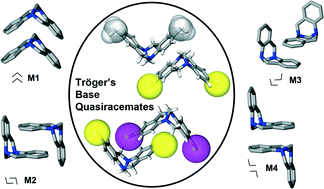Abstract
A family of 7 Tröger's base (TB) compounds that vary in configuration (quasiracemates, racemates, and enantiomers) and chemical substitutions (Me, Cl, and Br) has been investigated. The deliberate use of isosteric components provided a logical entry point to explore the quasiracemic behavior of TB compounds. Crystal structures of these quasiracemates contain several sets of molecular dimers organized by the complementary topologies of the quasienantiomeric components. These motifs closely mimic the local inversion symmetry environment observed with the racemic and solid-solution phases included with this study. Comparing this set of crystal structures to 105 TB entries found in the Cambridge Structural Database revealed four distinct dimeric packing patterns retrieved using TB⋯TB distance and orientation search criteria. Each motif takes advantage of the complementary topologies of the V-shaped building blocks and further highlights the importance of molecular shape to the recognition profile of these supramolecular assemblies. This approach exposed 58% of the entries (65 structures) exhibiting one or more of the pairwise relationships. Furthermore, sorting the entries based on centrosymmetric and noncentrosymmetric space groups provided evidence for a correlation between motif and crystallographic symmetry.

- This article is part of the themed collection: International Year of Crystallography Celebration: North America

 Please wait while we load your content...
Please wait while we load your content...